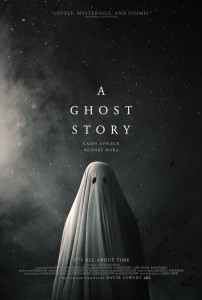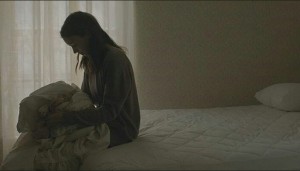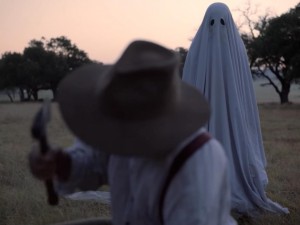Ladies and gentlemen, allow me this unique opportunity to offer a brief (and thoroughly simplified) lesson on cinematic aspect ratios and their historical significance. This is an important topic if we’re going to talk about “A Ghost Story.”
You see, in the long-ago era of early televisions, the screen roughly approximated what you’d see in a theater: it was more or less a square image. When these newfangled home entertainment centers proved detrimental to ticket sales, Hollywood responded with the then-revolutionary widescreen theatrical experience. Suddenly the image was, well, wider; the rectangular screen expanded the viewer’s vantage point in a way that was far more spectacular than anything the square box sitting in your living room was capable of replicating. Soon, nearly every big-budget film was using this new anamorphic ratio, and the trade-off was that if you wanted to watch said movie on your TV at home, either the image would be severely (and often catastrophically) cropped; or you’d have the entire image onscreen, albeit shrunken in size, and with black bars both above and below the picture. These days, televisions are now manufactured with widescreen in mind, allowing films to (mostly) fill the screen, with only minor negative space along the top and bottom for those films shot in a wide aspect ratio.
The point is, no one shoots in the traditional square, 4:3 aspect ratio anymore. This change started in the 1950s, and it’s all because people like their films BIGGER! LOUDER! FASTER! Everything has to be a roller coaster, or a theme ride; the products of WalMart, Diet Coke, and juvenile sensibilities further retarded by “The Bachelor” and superhero movies.
That’s what makes “A Ghost Story” so important: it’s the antidote to everything that represents. It’s shot and presented in 1.33:1, using actual celluloid. That means film — none of that digital shit. We’re talking silver halides and grain emulsion and breathtaking visual poetry. “A Ghost Story” is smarter than other films, which is exactly why you’ll hate it (and which is exactly why I love it). In fact, it’s your fault that the eventual DVD will come with some asinine disclaimer warning viewers not to change the picture mode on their TV, just like it’s your fault that there won’t be a VHS edition, and your fault the soundtrack won’t be released on vinyl.
From the very beginning, David Lowery (director of other Films with a capital F) signals that this cinematic voyage will be different from most. For one thing, the frame is the smallest of any other movie in release. So are the theaters in which it’s playing, but that’s not the point. Anyway, it starts, and we fade in on what tube TV-watchers used to call “full frame.” Then, immediately following the revelation of the film’s box-like, claustrophobic framing (which is totally justified since this a box-like, claustrophobic film), there comes a scene introducing our main characters: a husband (Casey Affleck) and his wife (Rooney Mara). They’re lying together, on the sofa, mumbling. No, you’re not supposed to understand what they’re saying, because they’re talking like real unscripted people! Meanwhile, the entire scene is punctuated every few seconds with masterfully executed strobe-like cuts to black. Why is this happening, you ask? I’d explain the significance to you, but I’m not here to hold your hand.
Our actors: Affleck and Mara. I’d give the characters names, except the film itself doesn’t. It’s more haunting that way; it creates an emotional disconnect between the art and the passive viewer, channeled through the verisimilitude of snapshot vignettes. The gulf is as wide and uncrossable as life and death, thematically preparing us for the moment in which Affleck dies in a car accident (albeit off screen because Lowery refuses to pander to the lowest common denominator by showing it). Affleck’s ghost ultimately rises from the morgue and haunts his earthly abode wearing a white sheet. No gore, no obnoxious jump moments: just ninety minutes of Affleck wearing a sheet and standing around watching things happen in sequences beautifully composed within that tight frame, the literal walls closing in like the veritable jaws of temporal inevitability.
What we’re treated to is stunning reality. What we see and hear and is the beauty of the mundane. What we feel is a response to the magic of the ordinary. Long, long duration takes, shot on a camera that’s locked down and doesn’t move, as things happen – or don’t happen! Witness the sequence at the beginning of the film in which we see the couples’ house beneath an evening sky; then Rooney comes out the front door, dragging a box. She slowly pulls it behind her, step by step by step by step, all the way down the lengthy front walk to the road; then she sets it there, turns around, and then walks slowly back to the house, step by step by step by step. Then she goes inside and closes the door…and we sit for another ten seconds, staring at the house. Is something going to happen? Is this molasses-like sequence building up to something that catches us off guard? No, it just fades to black because it’s art!
One scene stands out above all the rest, which is truly a remarkable feat in so profound a cinematic experience as this one. In it, Mara, who turns her chronic resting bitch face into the externalized half-consciousness of the newly widowed, eats an entire pie. This is not an exaggeration: she eats an entire pie, on camera. No cuts, no editing tricks. If you’ve ever wanted to see Rooney Mara, an actress best known for talking trash about the films she stars in, eat an entire pie in a sequence played out as the visual metaphor for filling the empty hole in one’s heart, then this is your opportunity. She eats that pie in real time as her dead husband stands there in a sheet and watches. Every bite seems like it’s the last, and yet isn’t. She takes another. And another. And another. She barely even takes time to swallow. The tension builds as she takes the pie from the counter top where she’s shoveling it, and then sits herself down on the kitchen floor, stabbing the delicious snack and masticating in her grief. Is it five minutes? Ten minutes? Who cares? We begin to lose a sense of time as reality stretches, the seconds becoming hours, the world outside our theater continuing to turn as we’re trapped here with Dead Affleck in a hellish 1.33:1 prison in which we’re impotent; and like him, we can do little more than passively witness the pie tin slowly emptying as Mara’s belly fills, until, at last, she vomits up the entire pie into the toilet. I’d bet an entire pack of clove cigarettes that she threw up for real, because she’s an artist. Take that, “Spider-Man: Homecoming.”
Just because people were walking out halfway through the film doesn’t mean anything; only that they’re too simple and intellectually stunted to appreciate “A Ghost Story.” They typify Joe Sixpack, the sort who would call it nonsensical, or pretentious, or say that “someone should have told Affleck to haunt a film with more life in it,” or “the movie ended last night and Mara’s probably still eating that pie.” They’d point out that the film is so fucking boring that Affleck and Mara, who look like they’re going to have sex at one point, fall asleep instead, right there in the middle of their own movie. All we can do is shake our heads, and be grateful for self-conscious art school snobbery, and the Austrian goat milk double-half-caf-half-decaf-soy milk cappuccino it’s washed down with. Now go read a book, idiot.
Directed by David Lowery
Written by David Lowery
Rated R for brief language and a disturbing image






Leave a Reply
You must be logged in to post a comment.